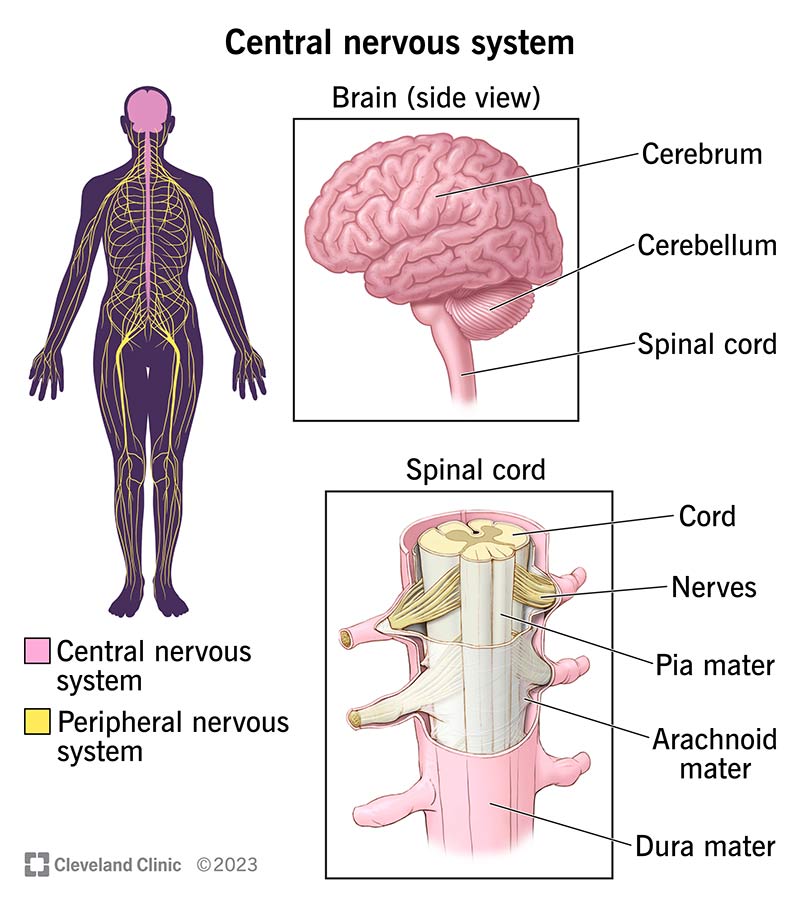Your central nervous system (CNS) is a processing center that manages everything that your body does, from your thoughts and feelings to your movements. Your brain and spinal cord are “central” to your CNS because they take in and send out information to your entire body.
Advertisement
Cleveland Clinic is a non-profit academic medical center. Advertising on our site helps support our mission. We do not endorse non-Cleveland Clinic products or services. Policy

Your central nervous system (CNS) is part of your nervous system. It consists of your brain and spinal cord. Your CNS collects information from your sensory nerves to process and respond to them. It regulates everything your body does.
Advertisement
Cleveland Clinic is a non-profit academic medical center. Advertising on our site helps support our mission. We do not endorse non-Cleveland Clinic products or services. Policy
The three main functions of your central nervous system are to:
After your brain gets and understands the data collected by your sensory neurons (nerve cells), it sends an electrical signal through your spinal cord to your muscles and glands to create a motor output. An example of this process is wanting to walk across the room. Your brain sends a signal through your spinal cord to the muscles in your legs. Your muscles react to this signal and allow you to complete the action (motor output) of walking.
Your brain regulates your thoughts, feelings and movements. It manages the things you do, like bending your fingers, learning and communicating. It also manages how your organs function by telling you to breathe and digest food. You likely don’t think about these things, but your CNS does.
This process works by sending messages through your nervous system. Your brain creates a message. It sends that message (signal) to your spinal cord. Your spinal cord sends the message to your nerves (peripheral nervous system) to complete an action. Signals travel to and from your brain and spinal cord to the rest of your body constantly to keep your body functioning.
Advertisement
Your brain and spinal cord make up your central nervous system.
Your central nervous system is located within your dorsal (back) body cavity. This includes the inside of your head and at the back of your trunk.
Your central nervous system looks like a balloon. Your brain is the round, inflated balloon. Your spinal cord is the string attached to the balloon. Your brain and spinal cord are held within bone structures, connective tissue (meninges) and fluid (cerebrospinal fluid), which protects them.
Several conditions can affect your central nervous system. Some of the most common include:
Signs and symptoms vary based on what condition affects your central nervous system. You might experience the following:
Contact emergency services immediately if you or a loved one experience symptoms of a stroke like confusion and paralysis on one side of your body. It’s also important to get medical help if you experienced an injury to your head that affects your vision, memory and/or awareness.
The following tests help your healthcare provider check the health of your central nervous system:
If you have a condition that affects your central nervous system, your healthcare provider will create a treatment plan to address your symptoms and the underlying cause. Treatment varies by type but may include:
Your central nervous system connects to all parts of your body. So, if you stay in good health, your CNS will feel good, too. You can take steps to stay healthy by:
In addition to your physical health, your central nervous system manages your thoughts and feelings. You can take care of your mental health by:
Advertisement
Talk to your healthcare provider about ways to keep yourself and your central nervous system healthy.
Your central nervous system (CNS) manages what your body does. This includes the things you think about doing, like walking and talking, and the things that your body does automatically, like breathing and keeping your heart beating.
Your CNS is very delicate and at risk of injury. You can take care of your CNS by taking care of your overall health, like eating healthy foods and exercising. Your mental health (thoughts and feelings) is an important part of what your CNS regulates. Taking steps to manage your complete health is best for your entire body, including your CNS.
Advertisement
If you have a neurological condition, you want expert advice. At Cleveland Clinic, we’ll work to create a treatment plan that’s right for you.

Last reviewed on 11/12/2023.
Learn more about the Health Library and our editorial process.